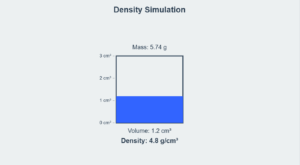Kinetic Energy Dimensional Analysis
Explore why certain formulas are dimensionally consistent while others are not
Select Kinetic Energy Formula
Dimensional Analysis
Adjust Parameters
Example 1.4
The SI unit of energy is \( J = \log m^2 s^{-2} \); that of speed \( v \) is \( m s^{-1} \) and of acceleration \( a \) is \( m s^{-2} \). Which of the formulae for kinetic energy \( K \) given below can you rule out on the basis of dimensional arguments (\( m \) stands for the mass of the body) :
(a) \( K = m^2 v^3 \)
(b) \( K = (1/2)mv^2 \)
(c) \( K = ma \)
(d) \( K = (3/16)mv^2 \)
(e) \( K = (1/2)mv^2 + ma \)
Answer: Every correct formula or equation must have the same dimensions on both sides of the equation. Also, only quantities with the same physical dimensions can be added or subtracted. The dimensions of the quantity on the right side are \( [M^2 L^3 T^{-3}] \) for (a); \( [M L^2 T^{-2}] \) for (b) and (d); \( [M L T^{-2}] \) for (c). The quantity on the right side of (e) has no proper dimensions since two quantities of different dimensions have been added. Since the kinetic energy \( K \) has the dimensions of \( [M L^2 T^{-2}] \), formulas (a), (c) and (e) are ruled out. Note that dimensional arguments cannot tell which of the two, (b) or (d), is the correct formula. For this, one must turn to the actual definition of kinetic energy. The correct formula for kinetic energy is given by (b).



